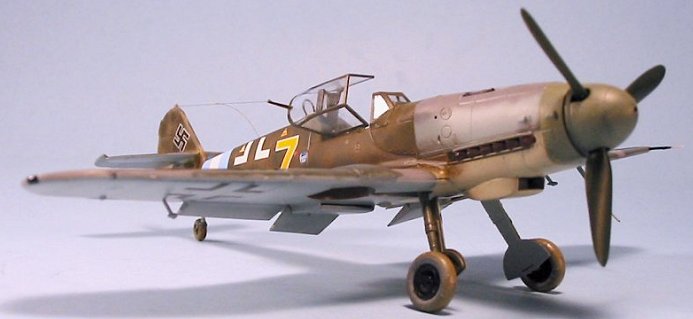
Hasegawa 1/48 Bf-109G-10
|
KIT # |
9468 |
|
PRICE: |
$ |
|
DECALS: |
Two Aircraft |
|
REVIEWER: |
|
|
NOTES: |
Cutting Edge Bf-109G-10 resin cockpit; Late Bf-109G spinner and prop; Decals: "109s Over Czech Terriroty #3" |

|
HISTORY |
The Messerschmitt Bf-109, with some 33,000 examples produced between 1936-45, may be the most-produced fighter in history. Under the Jagerprogramm created by Reich Minister of Production Albert Speer, production topped out when 3,300 new and remanufactured Bf-109s were delivered in September 1944. By that time it really didn't matter, inasmuch as there were not enough qualified pilots to fly the airplanes against the overwhelming Allied air superiority, or enough fuel to put them in the air in any numbers with any regularity.
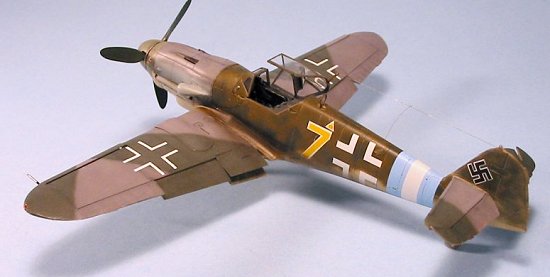 Sub-types of
109s proliferated, and not all were as interchangeable as mass-production
techniques are supposed to insure. The most-produced series, the
Gustav, saw attempts to stabilize production and bring everything to
one standard with the Bf-109G-6 of 1943-44, and the Bf-109G-14 of late
1944. The Bf-109G-10 was a sub-type that attempted to increase
high-altitude performance, and was in fact the fastest of the entire 109
series, with a top speed of 437 m.p.h. at rated altitude of 28,000 feet.
The G-10 was created by remanufacturing older airframes, mostly from the
G-6 sub-series, as well as the G-14. Interestingly enough, it became
operational in December 1944, after the debut of the Bf-109K-4,
the last new-production series.
Sub-types of
109s proliferated, and not all were as interchangeable as mass-production
techniques are supposed to insure. The most-produced series, the
Gustav, saw attempts to stabilize production and bring everything to
one standard with the Bf-109G-6 of 1943-44, and the Bf-109G-14 of late
1944. The Bf-109G-10 was a sub-type that attempted to increase
high-altitude performance, and was in fact the fastest of the entire 109
series, with a top speed of 437 m.p.h. at rated altitude of 28,000 feet.
The G-10 was created by remanufacturing older airframes, mostly from the
G-6 sub-series, as well as the G-14. Interestingly enough, it became
operational in December 1944, after the debut of the Bf-109K-4,
the last new-production series.
Leutnant Jorg Czypionka Chases "The Berlin Express":
Jorg Czypionka enlisted in the Luftwaffe in 1940 and took his flight training in southern Austria. Following completion of advanced training and before he could be sent to operational training, Czypionka was made a primary and basic flight instructor. "I have to say I loved that job," he recounts. "We flew the Fw-44, the He-72 and the (Bu-131) Jungmann, as well as high performance fighters, and I had a lot of time in the (Bu-133) Jungmeister. Those were wonderful, maneuverable airplanes, so much fun to fly. We were far from the war and able to build our flying skills. I know for a fact that it was my better flying skills that are why I can tell you this story."
By the summer of 1944, a pilot with Jorg Czypionka's skill was needed more in the cockpit of a fighter than a trainer, and he was posted to fighter training on the Messerschmitt Bf-109. "I really liked that airplane," he says fondly. "It was tricky, but wonderfully capable; when you're young, that's part of the challenge."
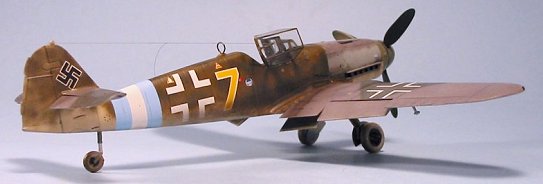 Leutnant
Czypionka was assigned to NachtJagdgruppe JG300, the "Wilde Sau"
unit that flew single-seat Bf-109s at night,and entered operational
combat in September 1944 from the Luftwaffe base at Juterborg,
southwest of Berlin. JG300's job was intercepting the RAF's Mosquito
bombers of the Light Night Striking Force, known as "The Berlin Express."
"We flew special 109G-6s and G-10s, with a three-stage blower. The
British would send sixty Mosquitos over at a time, targeted almost always
on Berlin."
Leutnant
Czypionka was assigned to NachtJagdgruppe JG300, the "Wilde Sau"
unit that flew single-seat Bf-109s at night,and entered operational
combat in September 1944 from the Luftwaffe base at Juterborg,
southwest of Berlin. JG300's job was intercepting the RAF's Mosquito
bombers of the Light Night Striking Force, known as "The Berlin Express."
"We flew special 109G-6s and G-10s, with a three-stage blower. The
British would send sixty Mosquitos over at a time, targeted almost always
on Berlin."
Czypionka admired both the Mosquito and its crews. "That airplane, it was so beautiful, it flew so well, I almost hated to have to try and shoot at it." In truth, the Nachtjagdgeschwader pilots had little success against the roaming Mosquitos. "They would send us off just before the British were to arrive. Our only hope was to get up to ten or eleven thousand meters and dive on them to catch them. If they were flying higher than eight or nine thousand meters, we had little chance, they were so fast."
The young
Leutnant nearly killed himself in October 1944, attempting to get a
Mosquito. "The controller put me right up in front of a group of them,
and I had the altitude to dive on them. One was caught by the
searchlights, and I went after him. I
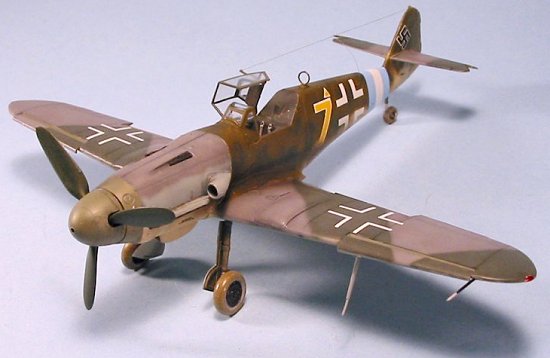 was diving on him
and he was still almost as fast as I was - it was such a beautiful plane!
- so I pushed the throttle into over-boost, into takeoff power. I
knew the engine wasn't going to like it, but I wanted to get him."
was diving on him
and he was still almost as fast as I was - it was such a beautiful plane!
- so I pushed the throttle into over-boost, into takeoff power. I
knew the engine wasn't going to like it, but I wanted to get him."
Czypionka dove from eleven to seven thousand meters with the searchlights sticking to the wild-flying Mosquito. Finally, just as he was about to pull into range, "The searchlights lost him and there I was in the darkness. And then, before I could throttle back, the engine exploded!" Oil burst from the engine all over the windscreen, and the engine compartment caught fire. "I was going to bail right out," he recalls, "and I got rid of the hood, but then the wind blew out the fire in the engine. It was definitely dead, but I stuck with it a little longer. I got all my gear and disconnected everything. I was really calm, much moreso than I would have expected. I could see the altimeter read almost five thousand meters when I got up on the back of the canopy, just like they instructed us, and pushed myself up so I would miss the rudder. There I was, falling up into space, and it was so beautiful in the night." He counted through several seconds of free fall, until he estimated his altitude at five hundred meters, at which point he pulled the ripcord.
"There I was,
back to reality. I was over a district with a lot of small lakes, and I
could see the moonlight and stars reflected on them." Not wanting to go
into the water because he was afraid of becoming tangled in his
parachute, Czypionka
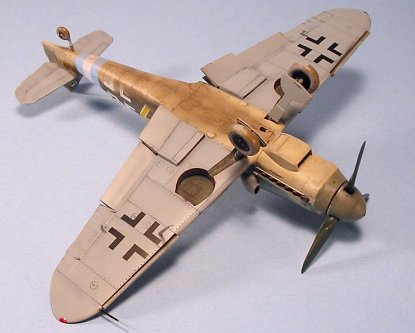 maneuvered towards the darker areas. At around
fifty meters, he fired his flare pistol to see where he was going to
land. "It was all trees! And then all of a sudden, something big and
black went past me and I hit something very hard." What Czypionka had
hit turned out to be the roof of a small brick factory right next to a
lake; the object he'd gone past was the chimney. "It took me a minute to
get my bearings," he continues, "and then I figured out where I was, and
also discovered I couldn't find a way down."
maneuvered towards the darker areas. At around
fifty meters, he fired his flare pistol to see where he was going to
land. "It was all trees! And then all of a sudden, something big and
black went past me and I hit something very hard." What Czypionka had
hit turned out to be the roof of a small brick factory right next to a
lake; the object he'd gone past was the chimney. "It took me a minute to
get my bearings," he continues, "and then I figured out where I was, and
also discovered I couldn't find a way down."
His shouts were eventually answered by the German night watchman, "an old gentleman who had that uniform with all the brass buttons," and his young Polish assistant, both of whom came out to see what the ruckus was about. "The old German watchman, he was going to get a ladder for me, but the young guy, he thought I was American, he kept calling me a terrorflieger and wouldn't let the old man go get the ladder." Finally, Czypionka threw down his wallet with his identification. "They went inside their office and looked at it, and when they came out it was 'Ja, ja, Herr Leutnant!' and they fell all over themselves saluting while they got that ladder out and helped me down." As if that wasn't enough, he still faced a night walk of several kilometers through the forest to get to a road where he caught a ride in a German Army truck that picked him up and returned him to Juterborg. He flew again the next night.
|
THE KIT |
Hasegawa has
owned the franchise on the Bf-109 series since their first kit, the
Bf-109E-3, appeared way back in 1987. At the time, it was the first
new-production World War II airplane to be created by a mainstream
manufacturer since the late 1970s, Hasegawa and others having been deeply
involved in bringing out the Phantom and other jet types of the '60s,
'70s and '80s. It would be four more years before Hasegawa would
graduate from the "E" to the "F", followed the next year by the
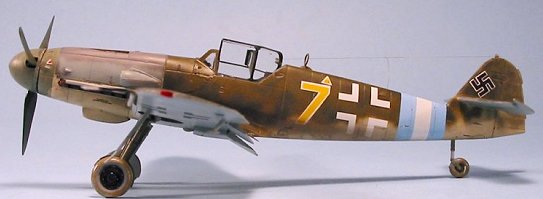 early "G"
series, and only concluding in 1999 with the release of the G-6, G-10 and
K-4. The company's commitment to doing the Bf-109 right, however, is
shown by their re-release of the Emil series in 1995-96 with the
fuselage contours refined and corrected from the earlier kits.
early "G"
series, and only concluding in 1999 with the release of the G-6, G-10 and
K-4. The company's commitment to doing the Bf-109 right, however, is
shown by their re-release of the Emil series in 1995-96 with the
fuselage contours refined and corrected from the earlier kits.
The kits are basically accurate, and certainly "accurate enough" for someone who wants a Bf-109 in their collection. For the serious "109 nut" however, there are numerous aftermarket companies with "correct" resin cockpits, spinners, props, and what have you of varying degrees of quality. Cutting Edge has released cockpits for all versions of the Hasegawa kit, as well as corrected props for the Bf-109F-K series. There are probably more aftermarket decals for the Bf-109 than all other kits combined. Since Meteor had provided me with their resin sets and decals for the Bf-109G-10 that included an airplane from JG300, and HLJ provided the newest limited-release of the G-10 kit, I decided to build a Bf-109G-10 that could have been flown by my friend Jorg Czypionka on the mission described above.
|
CONSTRUCTION |
Since I doubt
there is a modeler who builds 1/48 World War II aircraft who hasn't done
at least one each of the Hasegawa 109s, I will merely state here that
construction of the kit is - as always - straightforward and easy if one
follows the instructions. The basic 109F/G/K wing has holes to be
drilled out for the upper
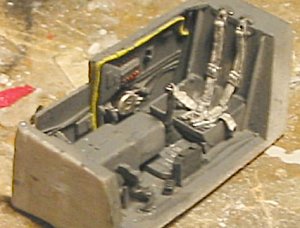 wing wheel bulges and the FuG16zy Morane
antenna. The cockpit is, as always, sparse in its detail though
acceptable, and the model will benefit from an aftermarket resin cockpit,
as I used here. I for one like the fact that the fuselage has been
changed so that the large cowling panels are not separate moldings as
they were on the 109F and early G kits; the new design allows for much
easier assembly.
wing wheel bulges and the FuG16zy Morane
antenna. The cockpit is, as always, sparse in its detail though
acceptable, and the model will benefit from an aftermarket resin cockpit,
as I used here. I for one like the fact that the fuselage has been
changed so that the large cowling panels are not separate moldings as
they were on the 109F and early G kits; the new design allows for much
easier assembly.
Once the resin cockpit was freed from its molding blocks, it was painted and detailed, then installed in the fuselage. Construction was straightforward past that. I decided to pose the model with flaps down, and slats and radiator cooling gills open.
Construction took an afternoon. After setting up overnight, it was time to go to the paint shop.
|
CAMOUFLAGE & MARKINGS |
Painting:
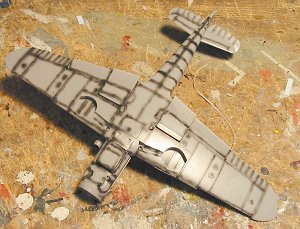 It seems that
new interpretations of Luftwaffe camouflage are constantly turning up.
When it gets to the late war variants, this is mostly done from trying to
interpret black-and-white photos of crashed Bf-109s being checked out by
American GIs. Recently some color photos taken by GIs have turned up in
the hands of Bf-109 historians, which has been helpful in figuring out
some of the newer colors.
It seems that
new interpretations of Luftwaffe camouflage are constantly turning up.
When it gets to the late war variants, this is mostly done from trying to
interpret black-and-white photos of crashed Bf-109s being checked out by
American GIs. Recently some color photos taken by GIs have turned up in
the hands of Bf-109 historians, which has been helpful in figuring out
some of the newer colors.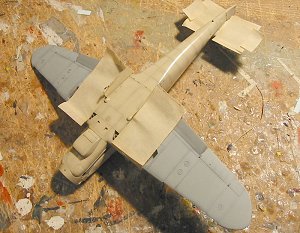
Most importantly - at least to me - is the analysis of the last Bf-109G in original Luftwaffe paint, which was done this past year by Brett Green. The airplane, a Bf-109G-6 which was once owned by the late Sid Marshall, is now in pieces in the Australian war museum, where Brett was able to examine it closely. I strongly urge anyone interested in this subject to cruise on over to HyperScale and look up the article, since its information is invaluable. This has also been published in book form by Eagle Editions.
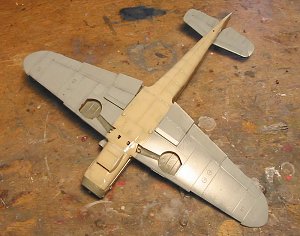 I decided to
paint the airplane as if it had been pre-painted in sub-assemblies. The
fuselage was in the "RLM84 Tan" color that historian Jerry Crandall had
shown me on a part from an Fw-190; this color is very close to
Gunze-Sangyo's "Sail Color," which is what I used - one could also use
Tamiya "Buff" for this color. The upper camouflage color was RLM81, for
which I used Gunze-Sangyo "Olive Drab" with some "Red Brown" mixed in for
fading. The engine cowlings were done in RLM76 and RLM75, as if they had
come from another airplane. The
I decided to
paint the airplane as if it had been pre-painted in sub-assemblies. The
fuselage was in the "RLM84 Tan" color that historian Jerry Crandall had
shown me on a part from an Fw-190; this color is very close to
Gunze-Sangyo's "Sail Color," which is what I used - one could also use
Tamiya "Buff" for this color. The upper camouflage color was RLM81, for
which I used Gunze-Sangyo "Olive Drab" with some "Red Brown" mixed in for
fading. The engine cowlings were done in RLM76 and RLM75, as if they had
come from another airplane. The
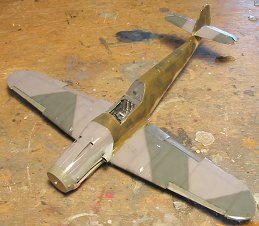 wings and horizontal tail surfaces were done with RLM76 lower surfaces and RLM75 and RLM83 upper camouflage. I
used Gunze-Sangyo "Medium Sea Grey" for the RLM75, since it has a violet
tinge to it, and "RAF Dark Green" for RLM83. The spinner was painted
RLM02 with RLM70 prop blades.
wings and horizontal tail surfaces were done with RLM76 lower surfaces and RLM75 and RLM83 upper camouflage. I
used Gunze-Sangyo "Medium Sea Grey" for the RLM75, since it has a violet
tinge to it, and "RAF Dark Green" for RLM83. The spinner was painted
RLM02 with RLM70 prop blades.
In terms of how this was done, I painted the wings, horizontal stabilizer and engine cowlings first, then masked them off and painted the fuselage camouflage, since it was so different from the rest.
Once the camouflage was painted, the entire model was shot with Future.
Decals:
The Cutting Edge decals provided the national and unit markings, as well as all the stenciling. These are thin decals that go down under a light coat of Micro-Sol with no difficulty.
|
FINAL CONSTRUCTION |
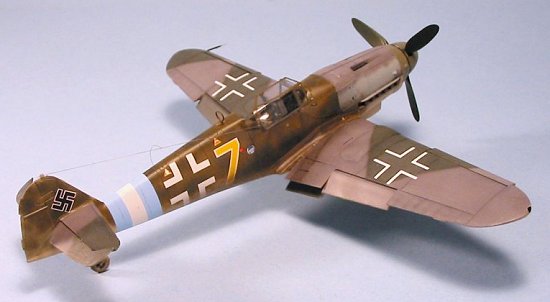 Once the decals
had set up, I Futured the model a second time, then used thinned Tamiya
"Smoke" for the exhaust and gun stains. Since the airplane was likely
newly-delivered, I did not "ding" it too much, other than in the obvious
places like the left wing where the pilot would board.
Once the decals
had set up, I Futured the model a second time, then used thinned Tamiya
"Smoke" for the exhaust and gun stains. Since the airplane was likely
newly-delivered, I did not "ding" it too much, other than in the obvious
places like the left wing where the pilot would board.
|
CONCLUSIONS |
I think the model demonstrates the enduring hold Luftwaffe models will have on modelers, with the wealth of camouflage differences and different markings possibilities one can create.
Thanks to HobbyLink Japan for providing the review copy.
July 2003
If you would like your product reviewed fairly and fairly quickly, please contact the editor or see other details in the Note to Contributors.